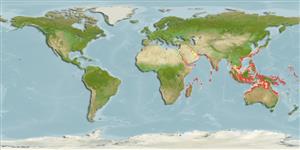Klassifizierung / Names
Namen | Synonyme | Catalog of Fishes(Gattung, Arten) | ITIS | CoL | WoRMS | Cloffa
>
Gobiiformes (Gobies) >
Gobiidae (Gobies) > Gobiinae
Etymology: Tomiyamichthys: occurring on sand-rubble bottoms in the vicinity of coral reefs.
Environment: milieu / climate zone / Tiefenbereich / distribution range
Ökologie
seewasser riff-verbunden; tiefenbereich 2 - 45 m (Ref. 90102). Tropical
Indo-West Pacific: Red Sea to Java (Indonesia) and the Great Barrier Reef (Australia).
Size / Gewicht / Alter
Geschlechtsreife: Lm ? range ? - ? cm
Max length : 10.0 cm TL Männchen/unbestimmt; (Ref. 30404)
Rückenflossenstacheln (insgesamt) : 6 - 7; Rückenflossenweichstrahlen (insgesamt) : 9 - 10; Afterflossenstacheln: 1; Afterflossenweichstrahlen: 8. Slender body with blotched pattern and large first dorsal, developing filaments in males (Ref. 30404); further characterized by white body color; 3-4 large brown blotches on side of body; back with smaller brown blotches; brown-edged orange spots on head; pelvic fins united medially; longitudinal scale series 49-50; mainly scaleless head, few embedded predorsal scales; greatest depth of body6.0-6.9 in SL; asymmetrically rounded caudal fin, about equal to head length (Ref. 90102).
Body shape (shape guide): elongated.
Inhabits open sand and rubble areas adjacent to reefs (Ref. 30404, 48637). Lives with the snapping shrimp Alpheus randalli (Ref. 30404).
Life cycle and mating behavior
Geschlechtsreife | Fortpflanzung | Ablaichen | Eier | Fecundity | Larven
Randall, J.E. and M. Goren, 1993. A review of the gobioid fishes of the Maldives. Ichthyol. Bull. J.L.B. Smith Inst. Ichthyol. (58):1-37, 5 pls. (Ref. 9360)
IUCN Rote Liste Status (Ref. 130435: Version 2025-1)
Bedrohung für Menschen
Harmless
Nutzung durch Menschen
Tools
Zusatzinformationen
Download XML
Internet Quellen
Estimates based on models
Preferred temperature (Ref.
123201): 25.7 - 28.6, mean 27.3 °C (based on 298 cells).
Phylogenetic diversity index (Ref.
82804): PD
50 = 0.5000 [Uniqueness, from 0.5 = low to 2.0 = high].
Bayesian length-weight: a=0.00724 (0.00339 - 0.01546), b=3.10 (2.92 - 3.28), in cm total length, based on LWR estimates for this (Sub)family-body shape (Ref.
93245).
Trophic level (Ref.
69278): 3.3 ±0.4 se; based on size and trophs of closest relatives
Widerstandsfähigkeit (Ref.
120179): hoch, Verdopplung der Population dauert weniger als 15 Monate. (Preliminary K or Fecundity.).
Fishing Vulnerability (Ref.
59153): Low vulnerability (10 of 100).
🛈
